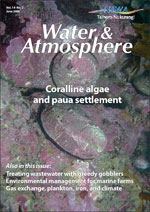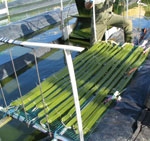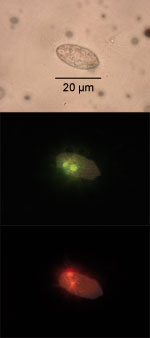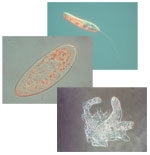PDF of this article (216 KB)



Rebecca Stott has met the diners of the microscopic set and reports on their favourite hangouts and cuisine. What she’s seen in their microcosmic cafe has implications for environmental and community health.
In the restaurant at the end of the wastewater pond, it’s a feeding frenzy. A bizarre array of free-living protozoa are gorging themselves on the lunchtime menu of faecal microbes. Flagellates whiplash their way through the murky soup of the day using their tails (flagella) to propel them through the water and round-up their bacterial prey. Around them cruise the ciliates: some search out tasty microbial morsels, others wait for passing bugs to be caught up in the vortex of their feeding currents. Predatory carnivorous ciliates patrol overhead, looking for an easy meal. Meanwhile, on the other side of the pond, obese shape-shifting amoebae ooze along the slimy walls, engulfing dislodged bacteria and other particles within jelly-like protrusions. This pond restaurant is open 24/7 and no faecal microbe is safe – the voracious appetites of the protozoan clientele are rarely satisfied.
Micro-consumerism at work
Free-living protozoa (FLP) feed on a variety of prey (including bacteria, algae, diatoms, and even other protozoa – see Types of protozoa below). They are greedy, although sometimes fussy, feeders and, depending on their size, they can ingest up to 120% of their body volume per hour.
The voracious grazing activity of these greedy gobblers is of great ecological value and of interest to NIWA, where research has been evaluating the relative importance of grazing by FLP in the removal of disease-causing faecal microbes – 'bad bugs' (see Bad bugs below) – from contaminated waters, particularly wastewater.
In the dark about wastewater disinfection?
Our work in natural wastewater-treatment systems (using ponds and wetlands) has shown that exposure to solar radiation is the main way that 'bad bugs' are destroyed in sunlight-exposed environments. But what happens at night, or in sun-exposed environments when the amount of radiation is reduced, as happens in winter or overcast weather? Other mechanisms – often referred to as 'dark' die-off processes – then become of greater importance. In these circumstances, the contribution of protozoan grazing to disinfection becomes significant. This 'dark' removal process is less well understood than sunlight disinfection of faecal microbes. Our research challenge has been to quantify the relative importance of protozoan grazing in conditions that reflect those found in real wastewater-treatment systems.
Dining out on bad bugs
We have developed a series of mesocosms to study how faecal microbes are removed by natural communities of FLP. A mesocosm is an experimental enclosure that we can use to manipulate environmental factors, such as light and protozoan grazers. For one type of mesocosm (shown in the first picture), we filled dialysis tubing (a semi-permeable membrane) with water and protozoan grazers from a wastewater-treatment pond. The we lowered the tubes into the pond to a depth of 20 cm, below the level of light penetration. The membrane prevents the grazers and microbes from escaping the mesocosm but allows the water in the tubes to equilibrate with the fluctuating environmental conditions in the pond.
To help identify dominant grazers, we have used fluorescent-labelled microspheres of similar size to faecal microbes (see photos). We compared removal rates of microspheres and faecal microbes in the presence or absence of protozoan grazers.
In our sunlight-excluded dark mesocosms we found that loss rates of bacteria (E. coli) and viral indicators from wastewater were slower than for sunlight-exposed mesocosms. But loss rates in dark mesocosms were higher in the presence of protozoan grazers than in mesocosms where grazing was inhibited or grazers were excluded by size filtration. Rates of E. coli removal also rose with greater numbers of flagellates and ciliates, that is, with greater grazing pressure. Grazing effects on loss of viral indicators was more difficult to interpret; both flagellates (at high numbers) and ciliates appeared to contribute to the removal of viruses.
FLP pick up the tab
Our studies in wastewater-treatment ponds have shown that grazing by microfauna such as protozoa is the dominant 'dark' removal process for faecal microbes. Protozoan grazing accounted for loss of up to 95% of E. coli and 61-82% of the viral indicators under 'dark' conditions. Furthermore, protozoan grazing was responsible for up to 40% of the overall removal of bacteria and viral indicators during summer sunlight exposure.
The cost of this fast-food protozoan-grazing service? No charge. Now, who ordered the bacteria burgers to go?
Snack menu
- Faecal microbes are removed from wastewater by sunlight disinfection and by non-sunlight (dark) processes.
- Protozoan grazing is the most important component of this 'dark' removal, and can eliminate 80-95% of bacteria and viral indicators.
- During sunlit summer conditions, the protozoan grazers can remove up to 40% of these faecal microbes.

Types of protozoa
Protozoa can be divided into free-living forms (such as Paramecium) and enteric forms (protozoa that live in the gut, many of which are disease-causing, such as Cryptosporidium). There are three major groups of free-living protozoa:
Flagellates (2-70 µm: most are less than 20 µm) propel themselves through the water by one or more long tail-like flagella on the body surface .
Ciliates (10-350 µm: most are less than 200 µm ) move by the beating action of numerous short hair-like cilia on the body surface.
Sarcodines (Amoebae) (10-600 µm: most are less than 50 µm) move by a gliding motion produced by lobe-like, pseudopodia (false feet) flowing out from the cell wall.
Bad bugs
Water-quality degradation by disease-causing microbial contaminants, or 'bad bugs' (viruses, bacteria, and parasites), is of increasing concern in New Zealand. Much of this microbiological contamination is diffuse pollution from livestock in pastures, although point sources from sewage and industrial wastewaters are still important. Processes for removing faecal microbial contaminants are therefore of interest in a range of different aquatic environments, particularly wastewater- treatment systems where disinfection of effluents is a crucial function.
Micro-facts
- Free-living protozoa are the most abundant group of phagotrophic organisms in the biosphere. (Phagotrophic means they feed by engulfing whole cells.)
- Estimates of numbers of FLP species range from 10,000 to 50,000.
- FLP habitats extend from the frozen soils of Antarctica to geothermal springs, from hypersaline lakes to acidic water draining from mines.
- Freshwater FLP are most abundant in standing water, where free-swimming planktonic forms predominate.
- In running water, the most abundant FLP forms are crawling over or attached to biofilms or the bottom.
- Ecological functions of FLP grazing activities include nutrient processing/cycling, and enhancing energy flow through microbial food webs.
Dr Rebecca Stott is an environmental microbiologist with NIWA in Hamilton, working on health-related water issues. This work on protozoan grazing was part of a Postdoctoral Fellowship at NIWA and supported through FRST capability funding.
Teachers’ resource for NCEA AS: Biology 90168 (1.8), 90464 (2.8), 90718 (3.6) Science 90188 (1.3), Level 4 US9833. See other curriculum connections at www.niwa.co.nz/pubs/wa/resources
